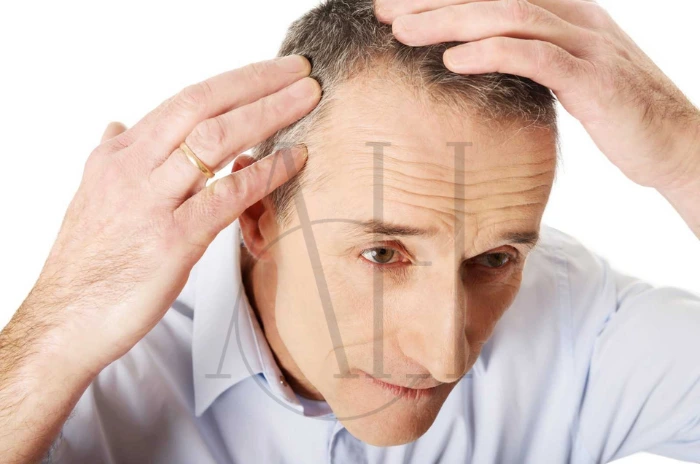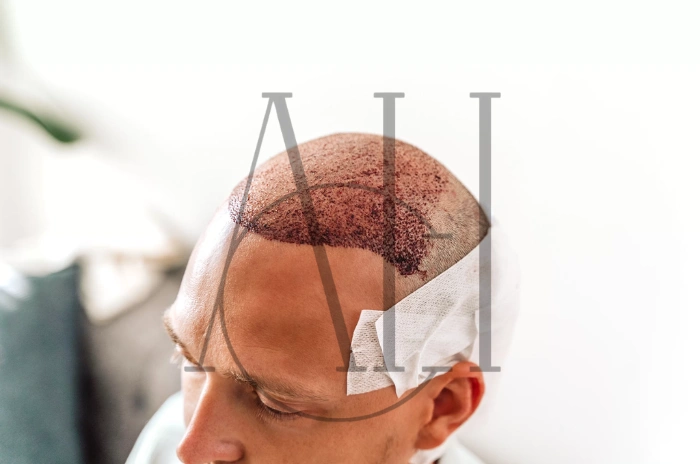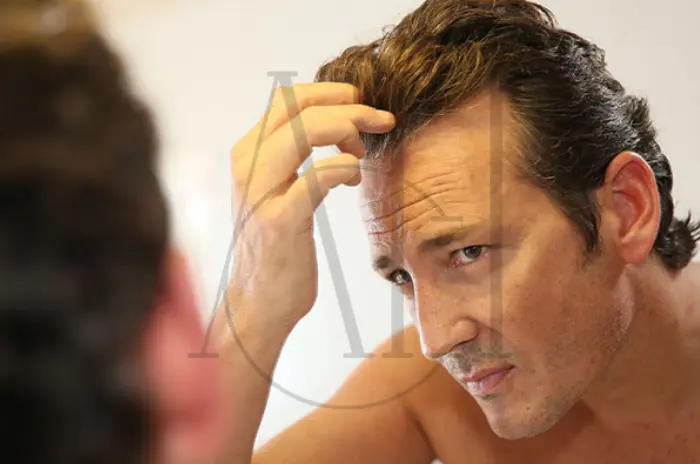Testosterone replacement therapy (TRT) offers significant benefits for men with low testosterone levels, but many users face an unexpected challenge: hair loss while taking testosterone. This comprehensive guide explores proven strategies to prevent hair loss testosterone treatments cause, helping you maintain both your hormonal health and your hair.
Understanding how to protect your hair during testosterone replacement therapy is crucial for maintaining confidence and appearance. While TRT hair loss affects many users, implementing the right prevention strategies can significantly reduce or even eliminate this side effect.
Table of Contents
ToggleWhy Testosterone Can Cause Hair Loss
Testosterone itself doesn’t directly cause hair loss, but its conversion to dihydrotestosterone (DHT) creates the primary culprit behind male pattern baldness TRT users experience. When testosterone levels increase through therapy, more hormone becomes available for conversion to DHT through the enzyme 5-alpha reductase.
DHT binds to hair follicle receptors, particularly on the crown and hairline, causing follicles to shrink over time. This process leads to progressively thinner, shorter hair strands until follicles eventually stop producing hair entirely. Understanding this mechanism is essential for developing effective hair loss prevention strategies.
How DHT Affects Hair Follicles
DHT attacks hair follicles by binding to androgen receptors in the scalp. Once attached, DHT signals the follicle to enter a shortened growth phase, producing increasingly weak and thin hair strands. Over multiple hair cycles, this continuous assault causes follicular miniaturization.
The process begins gradually, with hair becoming finer and shorter with each growth cycle. Eventually, affected follicles produce only vellus hair—the fine, colorless hair similar to peach fuzz. Without intervention, these follicles eventually become dormant, leading to permanent hair loss.
Role of Genetics in Testosterone-Related Thinning
Genetics play a crucial role in determining susceptibility to testosterone and DHT-related hair loss. Men with a family history of male pattern baldness carry genetic variants that make their hair follicles more sensitive to DHT’s effects.
The androgen receptor gene, located on the X chromosome inherited from your mother, significantly influences DHT sensitivity. Additional genetic factors affecting enzyme activity and hormone metabolism also contribute to individual hair loss patterns and severity.
How to Prevent Hair Loss While Taking Testosterone
Preventing hair loss while taking testosterone requires a multi-faceted approach targeting DHT production, follicle protection, and overall hair health. The key lies in understanding the underlying mechanisms and implementing evidence-based interventions early in your TRT journey.
Successful prevention strategies combine medical treatments, lifestyle modifications, and careful monitoring of hormone levels. By addressing multiple aspects of hair loss simultaneously, you can maintain both the benefits of testosterone therapy and your existing hair.
Understanding the Link Between Testosterone and Hair Loss
The relationship between testosterone and hair loss centers on DHT conversion and genetic predisposition. While testosterone replacement therapy increases total testosterone levels, it also provides more substrate for DHT production through 5-alpha reductase enzyme activity.
Individual responses to elevated testosterone vary significantly based on genetic factors, baseline hormone levels, and existing hair loss patterns. Men with early signs of male pattern baldness face higher risks when beginning TRT, making preventive measures especially important.
How DHT Contributes to Hair Thinning on Testosterone
DHT’s role in hair thinning involves complex interactions between hormones, genetics, and hair follicle biology. Elevated DHT levels from testosterone conversion accelerate the natural hair loss process in genetically susceptible individuals.
The hormone creates a hostile environment for hair follicles by shortening the anagen (growth) phase and extending the telogen (resting) phase. This disruption leads to increased shedding, reduced hair density, and progressive thinning in characteristic male pattern baldness distributions.
Medication Options for Protection
Several FDA-approved medications effectively protect against hair loss during testosterone therapy. These treatments work through different mechanisms, allowing for customized approaches based on individual needs and risk factors.
Medical interventions offer the most reliable protection against DHT-related hair loss. When started early and used consistently, these medications can preserve existing hair and often promote regrowth in affected areas.
How Finasteride Helps Block DHT
Finasteride represents the gold standard for DHT blocking and hair loss prevention during testosterone therapy. This medication inhibits type II 5-alpha reductase, the enzyme responsible for converting testosterone to DHT, reducing DHT levels by approximately 70%.
Clinical studies demonstrate finasteride’s effectiveness in stopping hair loss progression and promoting regrowth in many users. The medication works particularly well for crown thinning and can significantly slow hairline recession when used consistently.
| Medication | Mechanism | Effectiveness | Side Effects | Cost |
|---|---|---|---|---|
| Finasteride | Blocks 5α-reductase enzyme | 90% stop hair loss, 65% regrowth | Sexual dysfunction (2-4%) | Low |
| Minoxidil | Vasodilation, growth stimulation | 60% improvement in density | Scalp irritation, unwanted hair | Moderate |
| Ketoconazole Shampoo | Mild DHT blocking, anti-inflammatory | 30% improvement when combined | Scalp dryness, irritation | Low |
| PRP Therapy | Growth factor stimulation | 70% show improvement | Temporary soreness | High |
| LLLT | Photobiomodulation | 40-50% density improvement | None reported | High |
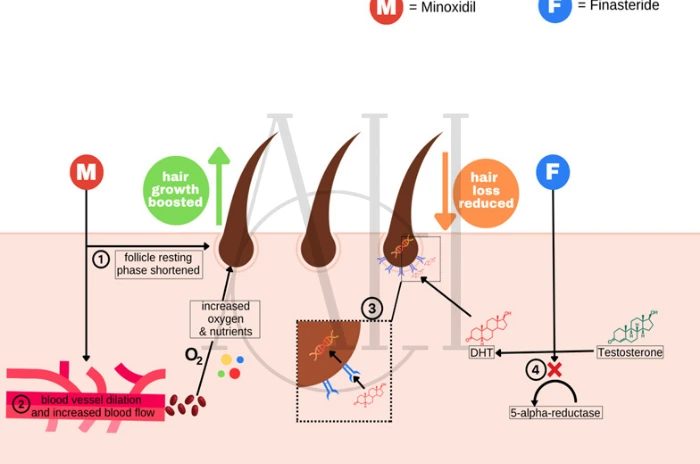
Using Minoxidil to Support Growth
Minoxidil complements DHT-blocking treatments by directly stimulating hair follicles and improving scalp circulation. This topical treatment extends the anagen growth phase and increases hair follicle size, leading to thicker, healthier hair strands.
Minoxidil for hair loss works independently of hormonal pathways, making it an excellent addition to finasteride therapy. The combination approach addresses both DHT reduction and direct follicle stimulation for optimal hair restoration results.
PRP Therapy: A Natural Hair Restoration Option
PRP therapy harnesses your body’s natural healing factors to promote hair regrowth and strengthen existing follicles. This treatment involves extracting platelet-rich plasma from your blood and injecting it directly into the scalp.
The growth factors in PRP stimulate cellular regeneration, improve blood flow, and extend hair growth phases. While requiring multiple sessions, PRP therapy offers a natural alternative or complement to medication-based treatments for hair restoration.
Ketoconazole Shampoo: Mild DHT-Blocking Effects
Ketoconazole shampoo provides mild DHT-blocking effects while addressing scalp inflammation that can worsen hair loss. This antifungal medication reduces local DHT production and creates a healthier scalp environment for hair growth.
Regular use of ketoconazole shampoo hair loss formulations can slow progression and improve hair quality when combined with other treatments. The anti-inflammatory properties also help reduce scalp irritation common with testosterone therapy.
Effective Treatments to Stop Hair Loss from Testosterone
Stopping hair loss from testosterone requires targeted treatments that address the root cause while supporting natural hair growth processes. Effective interventions combine DHT suppression with follicle stimulation for comprehensive protection.
Treatment success depends on early intervention, consistent use, and appropriate combination therapy. The most effective approaches target multiple pathways simultaneously while monitoring for optimal results and adjusting protocols as needed.
Finasteride: How It Blocks DHT and Protects Hair
Finasteride works by selectively inhibiting 5-alpha reductase type II, significantly reducing scalp DHT levels without substantially affecting other hormones. This targeted approach preserves testosterone’s beneficial effects while protecting hair follicles from DHT damage.
The medication’s protective effects become apparent within 3-6 months of consistent use, with maximum benefits typically achieved after 12-24 months. Finasteride testosterone hair loss prevention requires ongoing use, as benefits diminish when treatment discontinues.
Minoxidil for Hair Regrowth While on Testosterone
Minoxidil for testosterone hair loss provides direct follicle stimulation independent of hormonal pathways. This dual approach addresses both DHT reduction and growth promotion for comprehensive hair loss management during TRT.
The medication improves follicular blood flow, delivers essential nutrients to hair roots, and promotes the transition from telogen to anagen phases. Minoxidil works synergistically with DHT blockers to maximize hair regrowth potential.
Ketoconazole Shampoo to Reduce Scalp DHT
Ketoconazole shampoo reduces local scalp DHT production while addressing secondary factors that contribute to hair loss. The medication’s anti-inflammatory properties help calm irritated follicles and create optimal conditions for hair growth.
Regular use helps maintain scalp health, reduces dandruff and seborrheic dermatitis, and provides mild DHT-blocking effects. This best shampoo for testosterone hair loss serves as an excellent adjunct to primary treatments.
Low-Level Laser Therapy (LLLT) for Hair Regrowth
Low-Level Laser Therapy (LLLT) stimulates hair follicles through photobiomodulation, increasing cellular energy production and promoting healthier hair growth. This non-invasive treatment complements medication-based approaches without interfering with testosterone therapy.
The red light wavelengths used in LLLT penetrate the scalp to stimulate mitochondrial activity in hair follicles. Regular treatments can improve hair density, thickness, and growth rate when used consistently over several months.
Natural Ways to Reduce Hair Loss on Testosterone
Natural DHT blockers and lifestyle interventions offer additional support for hair loss prevention during testosterone therapy. While typically less potent than prescription medications, natural approaches provide valuable complementary benefits with minimal side effects.
Combining natural methods with medical treatments creates a comprehensive approach to hair loss prevention. These strategies support overall hair health while addressing nutritional deficiencies and lifestyle factors that influence hair growth.
Diet and Supplements for Healthier Hair Growth
A balanced diet hair growth plan includes essential nutrients like biotin, zinc, iron, and vitamins D and B-complex. These nutrients support hair follicle function, protein synthesis, and overall hair health during testosterone replacement therapy.
Vitamins for hair loss prevention include saw palmetto, pumpkin seed oil, and green tea extract, which possess mild natural DHT blockers properties. While less potent than medications, these supplements can provide additional protection when used consistently.
| Nutrient/Supplement | Daily Dosage | Hair Health Benefits | Food Sources | DHT Blocking Effect |
|---|---|---|---|---|
| Biotin | 5,000-10,000 mcg | Keratin production, hair strength | Eggs, nuts, sweet potatoes | None |
| Iron | 18 mg (men), 8 mg (women) | Oxygen transport to follicles | Red meat, spinach, lentils | None |
| Zinc | 11 mg | Protein synthesis, cell division | Oysters, beef, pumpkin seeds | Mild |
| Vitamin D | 1,000-4,000 IU | Follicle cycling, immune function | Fatty fish, fortified foods | None |
| Saw Palmetto | 320 mg | DHT inhibition | Supplement form | Moderate |
| Pumpkin Seed Oil | 1,000 mg | 5α-reductase inhibition | Pumpkin seeds | Moderate |
| Green Tea Extract | 400 mg EGCG | Antioxidant, mild DHT blocking | Green tea | Mild |
| Omega-3 | 2,000 mg | Anti-inflammatory, scalp health | Fish oil, walnuts | None |
Scalp Massage and Essential Oils for Hair Retention
Regular scalp massage improves blood circulation, delivers nutrients to hair follicles, and may help reduce DHT accumulation in scalp tissues. Combining massage with essential oils like rosemary and peppermint enhances circulation benefits.
Essential oils provide additional natural DHT blockers effects while improving scalp health and reducing inflammation. The mechanical stimulation from massage also helps distribute natural oils and remove cellular debris from follicles.
Lifestyle Tips to Prevent Hair Loss on TRT
Lifestyle modifications play a crucial role in maintaining hair health during testosterone replacement therapy. These changes support overall hair growth while minimizing factors that can exacerbate hair loss in TRT users.
Implementing comprehensive lifestyle changes creates an optimal environment for hair health. These modifications work synergistically with medical treatments to maximize hair loss prevention effectiveness.
Stress Management and Its Impact on Hair Health
Chronic stress elevates cortisol levels, which can accelerate hair loss and interfere with testosterone therapy benefits. Effective stress management through meditation, regular exercise, and adequate sleep supports both hormonal balance and hair health.
Stress reduction techniques help regulate the hypothalamic-pituitary-adrenal axis, reducing cortisol’s negative effects on hair follicles. Incorporating stress management into your daily routine provides long-term benefits for hair loss prevention.
Avoiding Harsh Hair Products That Worsen Hair Loss
Chemical treatments, excessive heat styling, and harsh hair products can damage already vulnerable hair during testosterone therapy. Switching to gentle hair care products reduces mechanical and chemical stress on hair follicles.
Sulfate-free shampoos, minimal heat styling, and protective hair treatments help preserve hair quality and reduce breakage. Gentle hair care on TRT becomes especially important as hair may become more fragile during treatment.
Eat Protein, Healthy Fats, and Vitamins
Adequate protein intake supports hair keratin production, while healthy fats provide essential fatty acids for follicle health. A balanced diet hair growth plan includes lean proteins, omega-3 fatty acids, and antioxidant-rich foods.
Specific nutrients like iron, zinc, and vitamins B-complex and D play crucial roles in hair growth cycles. Ensuring adequate intake through diet or supplementation supports optimal hair health during testosterone replacement therapy.
Manage Stress with Sleep, Exercise, Relaxation
Quality sleep supports hormone regulation and cellular repair processes essential for healthy hair growth. Aim for 7-9 hours of consistent, quality sleep to optimize recovery and hormone balance.
Regular exercise improves circulation, reduces stress hormones, and supports overall health. Combined with relaxation techniques, these practices create optimal conditions for hair loss prevention during TRT.
Exercise Regularly to Support Scalp Health
Physical activity improves blood circulation to the scalp, delivering essential nutrients and oxygen to hair follicles. Regular exercise also helps regulate hormone levels and reduce stress-related hair loss.
Cardiovascular exercise and resistance training both contribute to improved circulation and hormonal balance. Maintaining an active lifestyle supports both testosterone therapy benefits and hair health maintenance.
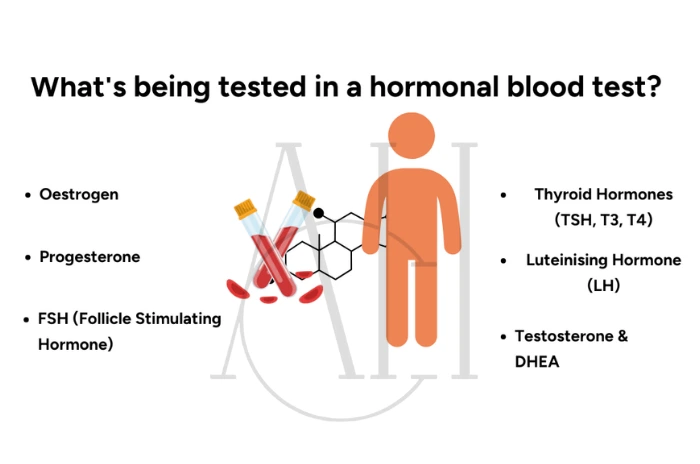
Monitoring Hormones with Blood Tests
Regular hormone monitoring helps optimize testosterone replacement therapy while minimizing hair loss risks. Blood tests provide valuable information for adjusting treatment protocols and implementing targeted interventions.
Comprehensive hormone panels guide treatment decisions and help identify early signs of hormonal imbalances that could accelerate hair loss. Regular monitoring allows for proactive adjustments to maintain optimal results.
Test Testosterone and DHT Levels
Monitoring total and free testosterone levels ensures therapeutic targets are achieved without excessive elevation that could increase DHT conversion. DHT testing provides direct insight into the hormone most responsible for hair loss.
Regular testing allows healthcare providers to adjust testosterone dosing and timing to minimize DHT production while maintaining therapeutic benefits. This personalized approach optimizes both treatment efficacy and hair loss prevention.
Check Estrogen, SHBG, Iron, and Vitamin D
Estrogen levels affect hair growth cycles and can influence hair loss patterns during testosterone therapy. SHBG (sex hormone-binding globulin) impacts free hormone availability and should be monitored regularly.
Iron deficiency and vitamin D insufficiency can worsen hair loss independent of testosterone effects. Regular testing identifies and corrects these deficiencies to support optimal hair health during TRT.
Diet and Hydration for Hair Strength
Proper nutrition and hydration form the foundation of healthy hair growth during testosterone replacement therapy. A well-planned diet provides essential building blocks for strong, resilient hair that can better withstand hormonal changes.
Nutritional support becomes especially important during TRT as the body adapts to hormonal changes. Adequate nutrition helps maintain hair quality and supports the effectiveness of medical treatments.
Eating a Balanced Diet for Healthy Hair
A balanced diet hair growth plan emphasizes whole foods rich in proteins, healthy fats, vitamins, and minerals. Focus on lean meats, fish, eggs, nuts, seeds, fruits, and vegetables to provide comprehensive nutritional support.
Specific foods like salmon, spinach, sweet potatoes, and berries provide targeted nutrients for hair health. Balanced diet hair growth strategies should be maintained consistently to support long-term hair health during testosterone therapy.
Drinking Enough Water to Reduce Shedding
Adequate hydration supports cellular function throughout the body, including hair follicles. Dehydration can worsen hair loss by reducing nutrient delivery and waste removal from follicular tissues.
Aim for 8-10 glasses of water daily, adjusting for activity level and climate. Proper hydration supports scalp health, improves circulation, and helps maintain optimal conditions for hair growth during TRT.
Gentle Hair Care Tips While on Testosterone
Gentle hair care on TRT becomes crucial as hair may become more sensitive to mechanical and chemical damage. Adapting your hair care routine protects existing hair while supporting regrowth efforts.
Implementing gentle practices reduces additional stress on hair follicles already challenged by hormonal changes. These modifications help preserve hair quality and support the effectiveness of medical treatments.
Avoiding Harsh Hair Treatments and Chemicals
Chemical processes like bleaching, perming, and frequent coloring can severely damage hair during testosterone therapy. These treatments weaken hair structure and can accelerate hair loss in vulnerable individuals.
Minimize chemical exposure by extending time between colorings, choosing ammonia-free products, and opting for gentler alternatives. Protecting hair from chemical damage supports overall hair loss prevention efforts.
Choosing Gentle Styles to Prevent Breakage
Tight hairstyles that pull on hair roots can cause traction alopecia, worsening existing hair loss patterns. Choose loose, comfortable styles that minimize mechanical stress on hair follicles.
Avoid tight ponytails, braids, and hair accessories that create tension. Gentle hair care includes using wide-tooth combs, silk pillowcases, and protective styles that reduce friction and breakage.
Use Mild Shampoos and Scalp Care
Gentle hair care on TRT includes using sulfate-free shampoos that clean without stripping natural oils. Look for products specifically formulated for thinning hair or sensitive scalps.
Incorporate scalp treatments like ketoconazole shampoo 2-3 times weekly while using gentle alternatives on other days. This balanced approach maintains scalp health while providing therapeutic benefits.
Natural Prevention Methods
Natural DHT blockers and holistic approaches provide additional support for hair loss prevention during testosterone therapy. While typically less potent than prescription medications, natural methods offer valuable benefits with minimal side effects.
Combining natural approaches with medical treatments creates a comprehensive strategy for maintaining hair health. These methods address multiple aspects of hair health while supporting overall wellness.
Essential Vitamins and Nutrients for Hair Growth
Vitamins for hair loss prevention include biotin, vitamin D, iron, zinc, and B-complex vitamins. These nutrients support cellular processes essential for healthy hair growth and follicle function.
Specific supplements like saw palmetto, pumpkin seed oil, and pygeum contain compounds that naturally inhibit 5-alpha reductase enzyme activity. While effects are modest compared to finasteride, these natural DHT blockers provide additional protection.
Herbal DHT Blockers That Actually Work
Evidence-based natural DHT blockers include saw palmetto extract, green tea catechins, and pumpkin seed oil. These compounds demonstrate measurable effects on DHT production and hair growth in clinical studies.
Nettle root extract and pygeum bark also show promise as mild DHT inhibitors. While requiring higher doses and longer treatment periods than medications, these herbs provide natural alternatives or complementary support.
Scalp Massage Techniques for Better Circulation
Regular scalp massage improves blood flow, reduces stress hormones, and may help redistribute DHT away from follicles. Use fingertips to apply gentle pressure in circular motions across the entire scalp.
Combine massage with essential oils like rosemary, peppermint, or cedarwood for enhanced benefits. Perform 5-10 minute sessions daily to maximize circulation improvements and stress reduction effects.
When to See a Hair Specialist
Consulting a dermatologist or hair specialist becomes important when hair loss progresses despite preventive measures or when considering advanced treatments. Professional evaluation can identify underlying causes and optimize treatment protocols.
Early consultation allows for timely intervention and access to cutting-edge treatments not available over-the-counter. Hair specialists can also coordinate care with your TRT provider for optimal results.
Professional evaluation is recommended if you experience rapid hair loss, unusual patterns of thinning, or inadequate response to standard treatments. Hair specialists can perform detailed assessments and recommend advanced treatments like PRP therapy, hair transplantation, or experimental protocols.
Dermatologists specializing in hair restoration stay current with emerging treatments and can provide personalized recommendations based on your specific hair loss pattern, testosterone therapy protocol, and treatment goals.
FAQ : How to Prevent Hair Loss While Taking Testosterone Effectively
Why does testosterone therapy sometimes cause hair loss?
Testosterone therapy can cause hair loss because excess testosterone converts to DHT through the 5-alpha reductase enzyme, and DHT attacks genetically sensitive hair follicles, causing them to shrink and eventually stop producing hair.
Can hair loss from testosterone be reversed or stopped?
Hair loss from testosterone can often be stopped and sometimes reversed using DHT-blocking medications like finasteride, growth stimulants like minoxidil, and comprehensive treatment approaches that address multiple aspects of hair health.
What are the most effective medications to prevent hair loss while on testosterone?
The most effective medications include finasteride for DHT blocking, minoxidil for growth stimulation, and ketoconazole shampoo for scalp health, with combination therapy typically providing the best results for hair loss prevention.
Are there natural ways to prevent hair loss when taking testosterone?
Natural DHT blockers like saw palmetto, pumpkin seed oil, and green tea extract can help, along with balanced diet hair growth approaches, stress management, scalp massage, and essential oils, though effects are typically milder than medications.
How does diet and hydration impact hair loss on testosterone replacement therapy (TRT)?
A balanced diet rich in proteins, vitamins, and minerals supports hair follicle health, while adequate hydration improves nutrient delivery to hair roots, both helping minimize hair loss during TRT.
Should I monitor my hormone levels if I’m experiencing hair loss on testosterone?
Regular monitoring of testosterone, DHT, estrogen, and related hormones helps optimize TRT protocols to minimize hair loss risks while maintaining therapeutic benefits through personalized dosing adjustments.
When should I consider seeing a hair specialist or dermatologist for hair loss on testosterone?
Consider consulting a hair specialist if you experience rapid progression, poor response to standard treatments, or want access to advanced treatments like PRP therapy or hair transplantation procedures.
Can lifestyle changes help prevent hair loss while on TRT?
Lifestyle modifications including stress management, gentle hair care, regular exercise, adequate sleep, and avoiding harsh hair treatments significantly support hair loss prevention efforts during testosterone replacement therapy.

